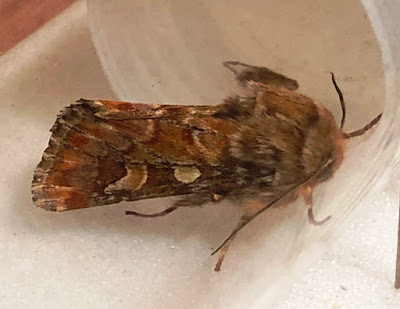Agonopterix ocellana was amongst several moths disturbed from vegetation in the garden yesterday when I mowed the lawn (...first time I can recall doing that in February here!), while 35 moths of 14 species came to light overnight which seemed like quite a reasonable result:
Agonopterix heracliana (3),
Emmelina monodactyla (1), March Moth (1), Shoulder Stripe (1), Spring Usher (1), Dotted Border (2), Early Moth (2), Pine Beauty (1), Small Quaker (2), Common Quaker (13), Clouded Drab (5), Hebrew Character (1), Satellite (1) & Chestnut (1). Of these, Pine Beauty and Small Quaker were first sightings for the year. As with Neil a few days ago, the very welcome Pine Beauty is by no means a regular here. Daytime temperatures may be down to more realistic figures now but some cloud cover means nights generally staying above freezing so, now that they're off the mark, I suspect
Orthosia numbers in particular will continue to build.
 |
| Pine Beauty, Westcott 27th February |
 |
| Small Quaker, Westcott 27th February |
Ignoring the micros, prior to this year the average number of macro-moth species recorded in the garden by the end of February was exactly ten and the highest number ever achieved here was 14 in 2017. So far in 2019 I'm on 20 with one night still to go. It has been an unbelievable year already...
Dave Wilton
Westcott, Bucks






























